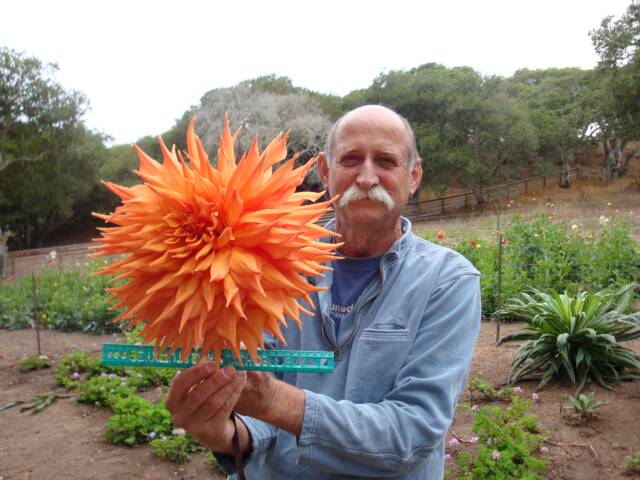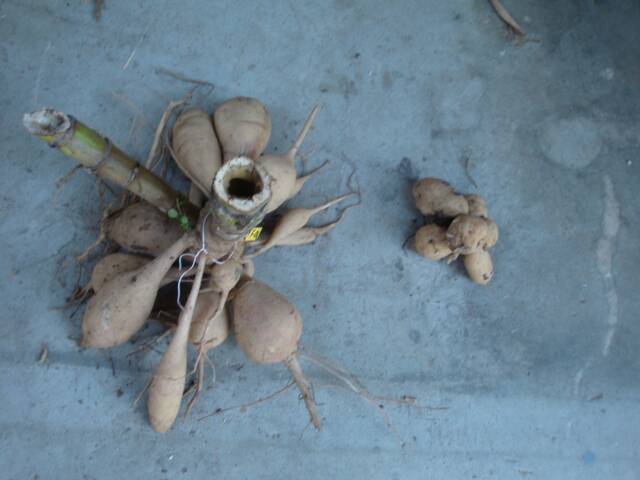Guide For Growing, Cutting and Storing Dahlias- 101
Dahlias were discovered in the mountains of Mexico by the Cortez expedition in the early 16th century. Dahlias were flourishing in a temperate climate at about a 6,000 foot altitude on the slopes of the Sierra de Ajusco Mountains. Dahlias are really easy to grow once you get the tuber to sprout and maintain well drained soil around it. Unfortunately, most people in American have completely different conditions to grow dahlias then what they require and all of us love them so much that we have all learned to grow them the best way we can. Every year the weather patterns change in your area and make the decisions of accurate growing a different challenge annually for the best results. Dahlia growers in your area know alot, and are worth consulting. We have learned moisture levels, organic nutrient in your soil, and being highly sensitive to your weather and irrigation systems is what it takes to grow dahlias. Even if someone gives you this information doesn't mean you will completely understand. It sometimes takes several years to start getting good at the learning curve. Dahlias will reward you all the way. So... it is worth it to try!
Location: Dahlias like warm conditions, sunny days, cool nights, medium of water after they have gotten about a foot high and good drainage. They will tolerate some shade but usually do not produce as many blooms and have less tuber growth.
Soil Preparation: About 2 weeks before planting work in amendments. Light sandy soil should have cow manure[ aged] or a 5-10-10 fertilizer worked in. Add bone meal into the bottom of the individual holes. Heavy soil needs to have lots of matter worked in to loosen and lighten up the dirt. Use as many leaves, sawdust, sand, and peatmoss to loosen the texture. Tubers will rot very quickly if the soil is too soggy and heavy.
Selecting Your Plants to Buy: We are doing research on the difference between planting tubers or a cutting. I'm sure this is controversial. However, it is disturbing that the difference is so drastically obvious.
However, pictures say a thousand words. Below, you will see the tuber clumps after an entire season of growth, the tiny clump is always the one grown from a cutting and the larger clump was grown from a tuber with no difference in location, soil, chemical additives, sunlight, water, fertilizer. It's obvious to us that cuttings produce weaker plants, some don't make it through the summer, they put out inferior blooms and less of them. Several of the pictures below were planted next to each other, so we could conduct this research under the best possible conditions. This is why we only sell tubers from a tuber grown plant so that we can continue to provide the highest quality and healthiest Dahlias for your landscaping and show entries. We only grow Dahlias in a traditional farming method. We do not force tubers to produce extra sprouts or take any cuttings from the plants to gain inventory. We are suggesting you do the same with your own Dahlia gardening.
Planting: Plant after last frost From April 1st, to June 15th, what ever is your period where the weather swings to warm spring. Make hole about 4-5". Place the tuber with the eye away from the stake. Cover the hole 2-3 feet apart, depending on the size of plants.[ small, miniatures and pompoms- 2 feet apart].
Cultivating: After plants are up, water thoroughly once a week to twice a week if really hot. Only light weeding is necessary., no deeper than 2" and no closer than 1 foot from the stake. Dahlias need very little water until they are about to start bloom. Most beginners put the tuber in the ground and water it , water it, water it, and it rots and dies. I suggest put it in the ground and don't water it for several weeks, because the spring ground already has moisture.
Once the plant starts to bloom, it needs water twice a week, possibly 3 times if really dry. When the plant has the 4th set of leaves, pinch off the top. This allows the plant to grow bushier with more blooms. For large blooms, pinch off the 2 side buds, leaving the center bud at the top at the end of each branch. Cut off old blooms to get more blooms. Use slug and snail bait when necessary until plants are 2 feet high. We are a natural [ no pesticides] farm, but if you must spray pesticides do it early in the morning or late at dusk.
Gophers: They love dahlia tubers. They will eat every tuber in your garden. Poison seed and pellets, traps, and gas bombs are available. Another method is to plant in a large wire basket [cage], Some people attach a hose to an exhaust pipe of a vehicle then insert it into the gopher hole and seal the dirt. The motor must run for 1/2 hour. At any rate, if you have gophers, they will keep you very busy!
Cut Flowers: You should get 8 to over 100 blooms per plant each summer. Cut flowers very early in the morning or late afternoon, put in water buckets immediately. Dahlias will completely wilt and die in 15 minutes if it is hot out and they are not in water. Display them in a cool area, out of direct sun light. Dahlias last 4-7 days in a vase, depending. If you cut blooms not completely opened up , they might not open any more than that.
Dig Up Tubers in the Fall: In the cold climate areas, it is best to dig up tubers by Oct 15 th to insure no frost damage. Do not dig your dahlias too early however, we recommend waiting to dig your dahlias until 2 weeks after a killing frost. If you have not had a frost by November 15, then it is safe to dig at that time. The tubers need time to harden off and prepare for winter storage. If you dig too early they will be "green" and will not store properly and may not survive storage.
If you have the option of leaving them in, then we recommend cutting the stalks down to ground level or just below the ground, where the stalk is solid. You do not want to leave a hollow stock open to fill with water over the winter, which may lead to the rotting of your tubers. If you have experienced this, then laying plastic over the ground where the dahlias are planted and then adding a "blanket of warmth" to the top of your dahlias for the occasional cold temperatures. The "blanket of warmth" could be straw, hay, dirt, leaves, mulch, or any material that will help protect them from the cold. The blanket will help add security for leaving your dahlias in the ground. Just remember leaving dahlias in the ground over the winter is never a guarantee. We are all at Mother Nature's mercy, just as it surprised many of us in the winter of 2009 with the cold snap where many avid dahlia growers lost their crop to the freeze.
If you are going to dig up and store for the winter: Cut the main trunks down to 6" above the ground a week prior to lifting out of the ground. This helps the eyes form. Put the shovel about 10" to 12" away from the stalk in several places to loosen the dirt till the tuber starts to appear. Carefully, they are fragile. If tubers break off from the clump without an eye it will be worthless. Wash the tubers off with the hose thoroughly with a strong water flow. When cutting tubers, remove the entire stem [they will cause rot] and select only firm divisions with visible eyes. Use a sharp knife. I use a Chicago Cutlery utility knife[ from Ace] seems to be the strongest. Keep the knife very sharp. And burn the blade after each plant to eliminate spreading virus. Mark each tuber with a permanent marker pen. Wash tubers again and let them completely dry. Dip the cut sections in fungicide, like Sulfer Dust to stop the tuber from rot issues. I had a problem with a sulfer dust by the company called Bonide- I had it tested and it has Benzole in it, which is quite deadly to humans. Major respiratory problems may occur, I suggest researching your fungicide carefully.
Packing Tubers: There are many theories on how to pack tubers for the winter. We feel a small amount of tubers in a plastic bag with course vermiculite [tubers not touching] works well. The bag should not be completely closed, the tubers need to breath. Keep the bags in the coolest place available around 40 degrees. If you smell rot, dump the bag and cut the rot off the plant , redip in fungicide and restore.
If the methods you use work well for you, continue to use them. Not all tubers have eyes, they will never grow. Tuber size does not affect plant growth or size.
Happy Spring, Summer and Fall to you all in your gardens for 2014!
May we all have a great year to come.
Elkhorn Gardens


